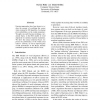46 search results - page 2 / 10 » Aligning ASL for Statistical Translation Using a Discriminat... |
ACL
2012
11 years 8 months ago
2012
Bayesian approaches have been shown to reduce the amount of overfitting that occurs when running the EM algorithm, by placing prior probabilities on the model parameters. We appl...
EMNLP
2009
13 years 4 months ago
2009
In this work, we propose two extensions of standard word lexicons in statistical machine translation: A discriminative word lexicon that uses sentence-level source information to ...
ACL
2008
13 years 7 months ago
2008
Automatic word alignment is a key step in training statistical machine translation systems. Despite much recent work on word alignment methods, alignment accuracy increases often ...
ACL
2007
13 years 7 months ago
2007
We present a general framework to incorporate prior knowledge such as heuristics or linguistic features in statistical generative word alignment models. Prior knowledge plays a ro...
IBPRIA
2003
Springer
13 years 11 months ago
2003
Springer
In statistical machine translation, single-word based models have an important deficiency; they do not take contextual information into account for the translation decision. A poss...

